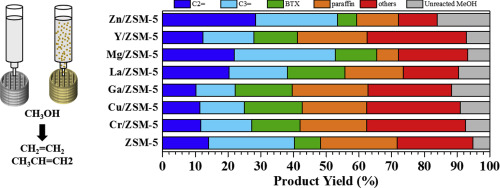Microporous and Mesoporous Materials ( IF 4.8 ) Pub Date : 2018-09-19 , DOI: 10.1016/j.micromeso.2018.09.016 Xin Li , Fateme Rezaei , Ali A. Rownaghi

|
In this study, activity and selectivity in methanol-to-olefins (MTO) reaction of Cr, Cu, Ga, La, Mg, Y, and Zn-doped 3D-printed ZSM-5 zeolite monoliths were evaluated and the appropriate dopants were screened through various analysis. These 3D-printed ZSM-5 zeolite monoliths were doped with the above metals by direct addition of metal nitrate precursors into the 3D printing paste thus the metal doping procedure was integrated with the 3D printing fabrication. The effect of dopants on physical and chemical characteristics of the doped monoliths was studied through XRD, XRF, N2 physisorption, FTIR, SEM-EDX, H2-TPR, and NH3-TPD. The performance of these printed metal–doped zeolite monoliths in MTO reaction was systematically evaluated and compared with their non-doped counterparts at 673 K for 24 h of reaction time. It was found that doping of Cr, Mg, and Y into 3D-printed ZSM-5 zeolite monoliths leads to enhanced methanol conversion, whereas doping of Ce, Cu, Ga and Y has little or no effect on catalysts reactivity. The olefins selectivity followed the sequence Zn > Mg > La > Y > Cr > Cu > Ga at 10 wt% dopant contents, in line with the relative amount of moderated acid sites in the monoliths. The results indicated that among all the investigated metal dopants, 3D-printed ZSM-5 zeolite monolith doped with 10 wt% Mg exhibited the favorable effect on the light olefins production and showed ethylene and propylene selectivity of 24% and 33%, respectively with methanol conversion approaching 95% at 673 K. The increased selectivity towards ethylene and propylene was correlated to the presence of moderate Brønsted acidity which inhibited the formation of paraffins and aromatics, consistent with the NH3-TPD results whereby moderate Brønsted acid sites were observed after Mg addition to 3D-printed ZSM-5 zeolite monoliths. The occupation of Mg dopant in the micropores, which is assigned to the cages of the ZSM-5 framework, took up the space for perspective aromatics, which are regarded to be coke precursors, and therefore reduced the coke formation.
中文翻译:

3D打印的ZSM-5整体催化剂上的甲醇制烯烃转化:金属掺杂,介孔率和酸强度的影响
在这项研究中,评估了Cr,Cu,Ga,La,Mg,Y和Zn掺杂的3D打印的ZSM-5沸石整料在甲醇制烯烃(MTO)反应中的活性和选择性,并筛选了合适的掺杂剂通过各种分析。通过将金属硝酸盐前体直接添加到3D打印浆料中,将这些3D打印的ZSM-5沸石整料掺入上述金属,从而将金属掺杂过程与3D打印制造集成在一起。通过XRD,XRF,N 2物理吸附,FTIR,SEM-EDX,H 2 -TPR和NH 3研究了掺杂剂对掺杂整料的物理和化学特性的影响。-TPD。系统地评估了这些印刷的金属掺杂的沸石整料在MTO反应中的性能,并将其与未掺杂的沸石整料在673 K下反应24小时的性能进行了比较。发现将Cr,Mg和Y掺杂到3D打印的ZSM-5沸石整料中会提高甲醇的转化率,而掺杂Ce,Cu,Ga和Y对催化剂的反应性几乎没有影响。在掺杂剂含量为10 wt%时,烯烃的选择性遵循Zn> Mg> La> Y> Cr> Cu> Ga的顺序,这与整料中适度酸位点的相对量一致。结果表明,在所有研究的金属掺杂剂中,掺有10 wt%Mg的3D打印ZSM-5沸石整料对轻烯烃的生产表现出有利的影响,并且对乙烯和丙烯的选择性分别为24%和33%,3- TPD结果表明,将镁添加到3D打印的ZSM-5沸石整料中后,观察到中等的布朗斯台德酸位。分配给ZSM-5骨架笼子的微孔中的Mg掺杂剂占据了透视芳烃的空间,芳烃被视为焦炭的前体,因此减少了焦炭的形成。




















































 京公网安备 11010802027423号
京公网安备 11010802027423号